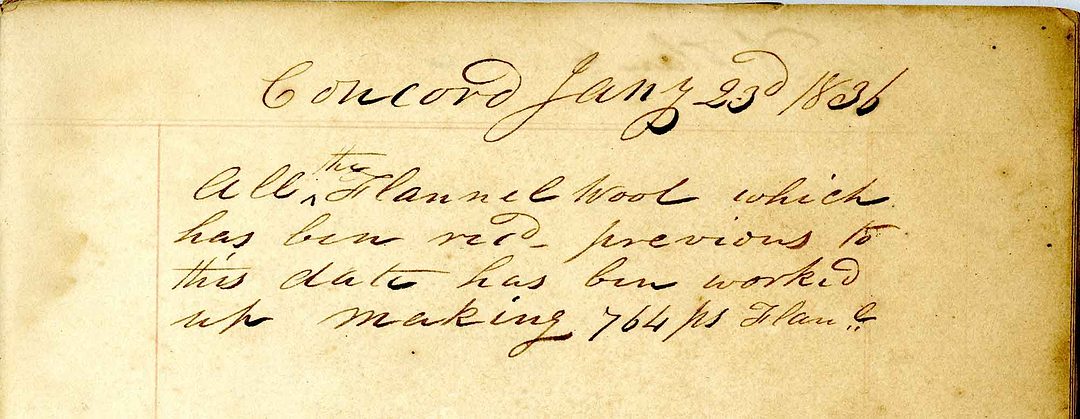
Welcome to the first in an ongoing series that gives you a sneak peek into Concord Free Public Library’s renowned Special Collections. The William Munroe Special Collections seeks to cultivate the most comprehensive collection of Concord, Massachusetts’ unique history, social and political life, culture, people, and landscape. To provide an understanding and appreciation of Concord’s history and culture through developing, preserving, interpreting, sharing, and promoting our Special Collections. The Special Collections include primary and secondary resource materials - such as papers and manuscripts, books, pamphlets, ephemera, broadsides, maps, photographic holdings, and works of art. In addition, the holdings of the Town of Concord Archives include historical vital records (births, deaths, and marriages), town meeting minutes, select board records, annual reports, and early town records.
Special Collections recently acquired family papers and business records related to the Damon family and the Damon Mill, a textile manufacturer which in the 19th century, operated on Main Street in West Concord, then known as Factory Village. Descendants of the textile mill owner Calvin Carver Damon donated a wealth of archival materials that enrich our understanding of the Damon family and their operation of the mill.
Thanks, in part, to the Assabet River, the Damon mill area has been associated with manufacturing since the 17th century, home to ironworks as well as saw, grist, and fulling mills. Calvin Damon, who had married Rebecca Poor Farnham in 1832, bought the mill in 1834, from James Derby, for $18,000. The mill had been producing satinet, a finely woven fabric made mainly from cotton, commonly used for men’s clothing. Calvin Damon eventually phased out the manufacture of satinet. Instead, he began manufacturing his original domett cloth (or domet), a cotton and wool flannel. Among the items donated is Calvin Carver Damon’s journal ledger, dated 1836-1851, which he kept while heading operations at the mill.
Calvin Damon’s son, Edward Carver Damon, took over mill operation at 17 upon his father’s sudden death in 1854. Edward, who had already spent considerable time working in all mill operations, increased production, made extensive repairs, and purchased new machinery. Edward married Anne Hagar Damon in 1860, together raising a large family and managing significant civic and social commitments.
In 1861, Damon Mill entered a contract with the United States government to produce fifty thousand yards of white cotton and wool flannel for the U.S. Army. As a result, business boomed, but a fire destroyed the mill only a year later, on June 19, 1862. Undeterred, Edward rebuilt the mill within just a year. He hired acclaimed Worcester architect Elbridge Boyden, who designed the new mill building in the Italianate style, which one can still admire today, at the intersection of Pond Lane and Main Street in West Concord. Edward also constructed tenement housing for his growing workforce, which employed men and women, and over the next two decades, the mill flourished, and the area, then known as Westvale, thrived and grew. In another decade, its name would change to Concord Junction, and later West Concord, as we know it today.
By the late 1880s, the mill was experiencing significant financial problems. Edward Damon, now joined in the business by his son Ralph, purchased controlling interest and reorganized as Damon Manufacturing Company. As the bank panic of 1893 spread throughout the nation, the mill operation was mortgaged to The Middlesex Institution for Savings. Finally, in 1898, as the textile industry declined, the bank sold the mill, spelling the end of the Damon Mill era. The recent donation includes Edward’s daybook from 1862 - 1881 and an account book from 1863-1894, documenting the growth and decline of mill operations.
Anne and Edward Damon were important figures in the town’s social life, attending lectures and events. While Edward’s daily entries note notable events in the mill’s operation, there is also much “daily life” in his journal, providing intriguing glimpses into Concord’s life in that era. Edward was instrumental in founding the Royal Arch Chapter of Masons, served on the Water Board, Library Committee (along with Ralph Waldo Emerson), Centennial Commission, School Committee (as did his wife, Anne), and was a member of the Social Circle. Anne was also an active member of the Concord Female Charitable Society and a director of Concord Home for the Aged. The recent gift includes a combination journal/ledger kept by Edward and Anne of personal and household expenses from 1854 to 1858.
The Damon Mill complex continued to function as a site for various manufacturers well into the 20th century, including as a mill for the Strathmore Worsted Company and as a cold storage facility for apples for fifty years. In the 1970s, developer Bill Sullivan, in partnership with Richard Damon, Calvin Carver Damon’s great-great-grandson, finally restored the building. After several years of work, it reopened as Damonmill Square and in 1980 earned a place on the National Register of Historic Places.


